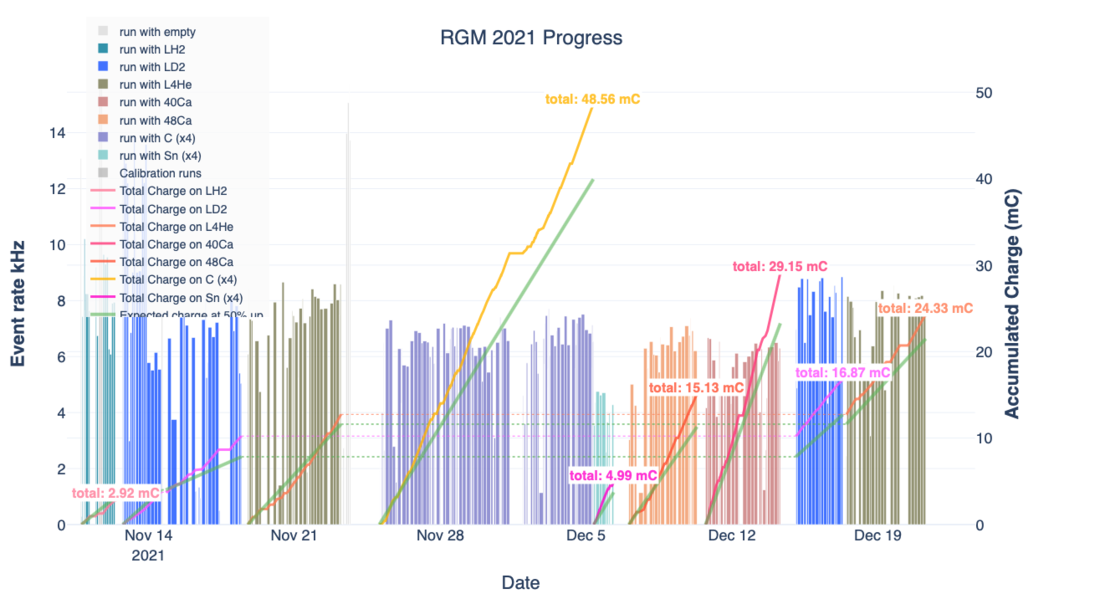Difference between revisions of "Run Group M"
| Line 85: | Line 85: | ||
| − | == <font color=blue>''' Run Plan: Jan 29 - Jan 31 2022 '''</font> == | + | == <font color=blue>''' Run Plan: Jan 29 - Jan 31, 2022 '''</font> == |
Production runs use <b> PROD67_noVTPread </b> and the trigger <b> rgm_6GeV_inb_v1_0.trg </b>.<br/> | Production runs use <b> PROD67_noVTPread </b> and the trigger <b> rgm_6GeV_inb_v1_0.trg </b>.<br/> | ||
Revision as of 19:48, 29 January 2022
- Shift Documentation
- Phone Numbers
- Short Term Schedule
- Notes/Known Issues
- Shift Expert
- Remote Worker Shift
- Monitoring
- Useful Links
Shift ScheduleESAD, COO, RSADShift ChecklistHot CheckoutBeam Time Accounting
|
Manuals |
Procedures |
JLab Logbooks
|
If calling local numbers (with area code prefix 757) from the counting room dial 9+[last 7 digits]. To call other area codes dial 91+[ten digit number]
|
| |||||||||||||||||||||||||||||||||||||||||||||||||||||||||||||||||||||||||||||||||||||||||||||||
- Note, all non-JLab numbers must be dialed with an area code. When calling from a counting-house landline, dial "9" first.
- To call JLab phones from outside the lab, all 4-digit numbers must be preceded by 757-269
- Click Here to edit Phone Numbers. Note, you then also have to edit the current page to force a refresh.
Click Here to edit Phone Numbers. Note, you then also have to edit the current page to force a refresh.
CLAS12 Run Group M, Fall 2021
Beam energies: 2.1, 4.0, 6.0 GeV (1.96 GeV/pass)
RC: Susan Schadmand and Sebastian Kuhn
- Susan Schadmand (757) 575-7540, susansch@jlab.org
- Sebastian Kuhn (757) 639-6640, kuhn@jlab.org
- 9 575 7540 from Counting Room
PDL: Valery Kubarovsky
- (757) 876-1789
- 9 876-1789 from Counting Room
- vpk@jlab.org
Run Plan: Jan 29 - Jan 31, 2022
Production runs use PROD67_noVTPread and the trigger rgm_6GeV_inb_v1_0.trg .
Run duration 100M events or 4 hours, whichever comes first.
- Running on Ar, with 22nA (determined by DC HV/current trips)
- Aiming for 1 B triggers with 22nA on LAr
- Low luminosity 2 hours at 5 nA: run 15760 events 11.3M
- Low luminosity 1 hour at 10 nA: run 15763 events 10.8M
- Return to 22nA on LAr until 20:30
- Empty Ar target (with Bob Miller on phone)
- Put beam blocker IN, are not loading FC calibration empty target, see https://logbooks.jlab.org/entry/3976506
- Take 2-3 hours of empty target runs (100-150 nA)
- Switch to C target ("Carbon target 2 mm")
- Beam blocker IN, FC calibration for C target is loaded
- Run with 80-90 nA
- Monday pass change (6GeV beam)
- Need to establish quality beam, repeat beam centering, beam blocker calibration.
- OUTLOOK: Run on Ar, Sn and C with 6 GeV beam
DAQ configuration
PROD67_noVTPread , production trigger rgm_6GeV_inb_v1_0.trg .
At the end of each run, follow the STANDARD DAQ RESTART SEQUENCE
- "end run", if the run ended correctly then: "prestart", "go"
- if the run did not end correctly or if any ROCs had to be rebooted:
- "cancel", "reset"
- "configure", "download", "prestart", "go"
- After each step, make sure it is completed in the Run Control message window. If a ROC has crashed, find which one it is, issue a roc_reboot command ON JUST THAT ROC and try again. Contact the DAQ expert if there are any questions.
References and Standards
(last update 01/18/2022- 23:30)
Nominal Beam Positions
- 2H01, X: -0.6 mm, Y: 0.8 mm
- 2C24, X: -2.0 mm, Y: +0.6 mm
FSD Thresholds
- Upstream: 2000 Hz
- Midstream: 2000 Hz
- Downstream: 500000 Hz
- BOM: 10000
- 5 ms dwell time
Reference Harp Scans for Beam on Faraday Cup: 2H01 [1]
Reference Harp Scans for Beam on Tagger dump: 2C21 [2], tagger harp [3]
Reference Monitoring Histograms (6 nA, production C) [4] Old reference Monitoring Histograms (50 nA, production LD2) [5]
Counter rates
- Upstream counters integrated rates: 0-15 Hz (acceptable up to 100 Hz are acceptable) @50 nA.
- Midstream counters: 10-20 Hz (acceptable up to 50 Hz) @50 nA.
- Counting rates of ~ hundreds of Hz may indicate bad beam tune or bleed-through from other Halls.
Beamline vacuum: should be not higher than 5e-5.
Notes
|
Known Issues
|
(remote) shift worker: see dedicated Remote Shifts tab above. |
|
TasksEvery Run:
Every Shift:
Regularly:
|
| ||||||||||||||||||
Webcams
|
Manuals |
Hall Webcams |
Epics on the web
|
Live Monitoring Links
|
|
|
Hall-B
Run lists |
AcceleratorReferences |
ZOOM meetings
|

